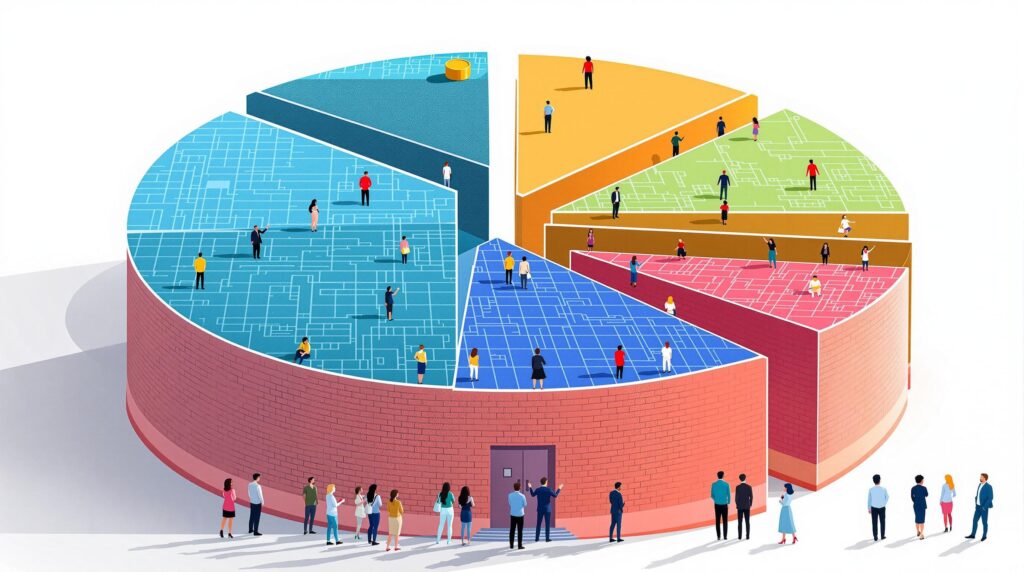[rev_slider alias=”slider-1″][/rev_slider]
The Emergence of Layer 1 Blockchains in Web3
Layer 1 blockchains serve as the bedrock of the Web3 ecosystem, marking a paradigm shift from traditional web systems. But what exactly sets them apart in the landscape of digital innovation? Let’s dive into their foundational characteristics and their transformative role in building Web3.
What are Layer 1 blockchains? Layer 1 blockchains, often referred to as base layer blockchains, are underlying architectures that manage the fundamental operations of a blockchain network, including transaction validation and network security.
Traditional web systems, while effective, rely heavily on centralized servers and data storage. This centralization can lead to single points of failure, potential data breaches, and significant privacy concerns. In contrast, Layer 1 blockchains like Ethereum or Bitcoin operate on a decentralized architecture, distributing data across numerous nodes globally. This decentralized setup empowers each node to hold a copy of the entire blockchain, boosting security and resilience against attacks.
“Decentralization is the core tenet of Layer 1 blockchains, offering a trustless environment where users can engage in peer-to-peer transactions without intermediaries.”
One of the critical advancements brought by Layer 1 solutions is improved transaction speed and scalability. For example, Ethereum’s shift to proof-of-stake with Ethereum 2.0 aims to enhance network throughput, addressing scalability challenges that plague older models.
- Transaction Finality: Layer 1 blockchains ensure that once a transaction is validated, it cannot be altered or reversed, providing users with a seismically robust trust model.
- Smart Contracts: Key to the Web3 ecosystem, Layer 1 blockchains support smart contracts – self-executing contracts with the blockchain’s code directly controlling execution.
- Security: By leveraging advanced cryptographic methods, Layer 1 blockchains provide unparalleled security, making them resistant to fraud and unauthorized activities.
The introduction of smart contracts has fundamentally changed how businesses can automate processes. For example, decentralized finance (DeFi) platforms using Layer 1 blockchains provide services like lending and borrowing without traditional banking systems. This advancement significantly enhances financial inclusivity, particularly in regions like Africa where traditional banking infrastructure may be lacking.
These blockchain systems are not without their challenges, notably scalability, which limits transaction throughput. Nonetheless, continued innovations in this space, such as sharding and layer 2 solutions, aim to tackle these issues head-on. Defense of blockchain innovations highlights how the legal framework continues to evolve alongside these technologies, underscoring the critical role of legal oversight in this burgeoning field.
Jara’s unique social-first approach and its flagship $6 billion Lagos airport tokenization project exemplify the powerful potential of Layer 1 blockchains to bridge infrastructure gaps, ushering in a new era of economic empowerment in Africa.
In summary, Layer 1 blockchains are not just the future of Web3, but they embody the very essence of decentralization – creating networks that are more secure, scalable, and inclusive. They hold boundless potential for revolutionizing how various sectors operate, unlocking new opportunities for innovation and financial growth across the globe, especially within the African continent.
For more insights on the intersection of blockchain technology and legal frameworks, explore resources on legal implications of emerging technologies to understand how law adapts to this dynamic environment.
Comparative Analysis: Layer 1 vs. Layer 2 Solutions
Key Differences and Synergies
Blockchain technology has revolutionized the way we think about data security, decentralization, and digital interactions. Two pivotal components within this innovation landscape are Layer 1 and Layer 2 blockchain solutions. But what distinguishes these two layers, and how do they work together to enhance blockchain technology?
Layer 1 blockchains form the base network, executing core operations and securing data through consensus mechanisms. Layer 2 solutions build on Layer 1 to improve scalability and transaction speed without compromising security.
Layer 1 blockchains act as the foundational layers of the blockchain ecosystem. They are responsible for critical functions such as security, decentralization, and the operation of core blockchain protocols. Common examples of Layer 1 blockchains include Bitcoin, Ethereum, and Jara’s own Caldera-based blockchain.
- Scalability: While Layer 1 ensures robust security and decentralization, it often faces challenges in scalability. The increasing demand for blockchain applications can lead to network congestion, higher transaction fees, and slower processing times, especially in popular networks like Ethereum.
- Security: Layer 1 blockchains are known for their security as they rely on extensive nodes to verify transactions. This decentralized verification process makes it difficult for any single entity to alter or corrupt the data.
- Decentralization: With numerous nodes participating in transaction validation, Layer 1 blockchains offer unparalleled decentralization, reducing the potential control any single entity might have over the network.
Layer 1 challenges have given rise to innovative solutions at Layer 2, designed to complement and enhance the foundational strengths of their predecessors.
Layer 2 solutions provide scalability enhancements without compromising the integrity of Layer 1 networks. They address the growing demand by offering faster transaction speeds and lower fees. Here’s how:
- Increased Scalability: By offloading transaction data processing from the main chain to secondary protocols, Layer 2 effectively reduces the load on Layer 1, thus enabling a higher transaction throughput.
- Cost Efficiency: With processes handled off-chain, Layer 2 solutions significantly reduce transaction costs, making it feasible for smaller transactions and micro-payments to occur.
- Interoperability: Layer 2 doesn’t replace Layer 1 but rather acts as an additional layer. This promotes interoperability across different blockchain networks, facilitating broader access and inclusion.
Just as a bustling city needs well-maintained roads and highways to manage traffic flow, Layer 2 acts as an infrastructural upgrade that elevates the performance of Layer 1 blockchains. Together, they ensure blockchain networks remain both secure and scalable, meeting the increasing demands of users.
“$JARA is not just part of the blockchain story; it’s shaping the future. Our proprietary L2 blockchain stands as a testament to the fusion of security, speed, and efficiency.” – Jara Team
In synergy, Layer 1 and Layer 2 solutions represent the evolution of blockchain technology, allowing platforms like Jara to offer cutting-edge solutions in Africa’s burgeoning digital landscape. As we explore their respective advantages, we begin to understand how they jointly safeguard the blockchain’s future.
Come learn more about these fascinating breakthroughs and explore how they are setting new standards in the digital finance world.
[rev_slider alias=”text-call-cta”][/rev_slider]
The Potential of Layer 1 Blockchains for Future Innovations
Have you ever wondered how Layer 1 blockchains could revolutionize industries beyond finance? As the backbone of many decentralized systems, these blockchains hold immense potential to transform diverse sectors such as healthcare, supply chain logistics, and even governance.
What is a Layer 1 blockchain? A Layer 1 blockchain is the base network in blockchain architecture, responsible for the primary protocol and consensus mechanism upon which other layers can build. It forms the foundation for decentralized applications and smart contracts.
Healthcare Transformation: Imagine a world where patient records are secured on blockchains, accessible only with proper authorization, and immutable, which guarantees accuracy. The integration of Layer 1 blockchains in healthcare could lead to increased data security, privacy, and efficiency through decentralized patient data management systems. By employing blockchains, healthcare providers can ensure interoperability among different systems, offering seamless care and real-time updates of patient records.
- Data Integrity: Blockchains can prevent unauthorized access and modifications to patient records, thereby maintaining data integrity.
- Interoperability: Leveraging a standardized blockchain protocol can bridge gaps between different healthcare systems, facilitating comprehensive care.
- Efficient Claims Processing: By automating insurance claims and operations through smart contracts, administrative burdens can be significantly reduced.
Supply Chain Logistics: The logistics sector can also benefit immensely from the transparency and traceability that Layer 1 blockchains provide. Picture a supply chain where every step of a product’s journey, from raw materials to final delivery, is recorded on a blockchain, accessible to all stakeholders.
- Provenance Tracking: Companies can verify the origin and authenticity of products, reducing counterfeit goods and enhancing product integrity.
- Transparency: All transactions and logistic operatives are logged on a public ledger, building trust among stakeholders.
- Cost Reduction: Streamlining operations and minimizing delays and fraud through blockchain transparency can lead to lower costs and increased efficiency.
The implications of these innovations are vast, not just streamlining existing processes but paving the way for entirely new business models. The potential applications extend far beyond healthcare and logistics; they can impact environmental sustainability, energy trading, and even real estate. These developments emphasize the need to delve deeper into the mechanics of these foundational technologies and explore their possible applications.
“Invest in $JARA: Fuel Africa’s $200B+ Digital Asset Economy and Participate in a Revolutionary Ecosystem” – Jara stands at the forefront of utilizing blockchain technology to transform Africa’s infrastructure and economic landscape.
Layer 1 blockchains are essential for handling large volumes of data, offering rapid transaction speeds, and supporting complex applications without compromising security. Their intrinsic scalability and adaptability position them as viable solutions for emerging technological challenges across a multitude of sectors.
Future Prospects of Layer 1 Blockchains
The defining characteristic of Layer 1 blockchains is their role as global, tamper-proof ledgers. They enable peer-to-peer transactions without intermediaries, reducing costs and potential points of failure. Their importance in upcoming technological advancements cannot be overstated.
- Decentralized Finance (DeFi): Beyond traditional banking and finance, blockchains facilitate intricate DeFi applications, providing financial services globally without central authority dependency.
- Smart Cities: Integrating Layer 1 solutions could lead to smarter resource management, energy efficiency, and enhanced city planning, contributing to sustainable urban development.
- Identity Verification: With immutable identity solutions on blockchains, issues of identity theft and fraud could become relics of the past, as personal data is securely stored and managed.
The future holds a wealth of possibilities with Layer 1 blockchains at the helm. Africa, with its rapidly evolving digital infrastructure, is uniquely positioned to leverage these advances through initiatives like Jara’s innovative projects. By investing in tokenized real-world assets and championing next-generation blockchain infrastructure, Jara bridges global capital with African innovation, laying the groundwork for a transformative ecosystem.
Challenges Facing Layer 1 Blockchains
In the rapidly evolving landscape of Layer 1 blockchains, there’s a constant demand to scale and reduce transaction costs. However, these foundational blockchain solutions face significant hurdles that need addressing if they are to lead the future of Web3, particularly within the African context.
Scalability Issues
Most Layer 1 blockchains, such as Bitcoin and Ethereum, encounter scalability issues due to their design principle of maintaining decentralization and security. This trifecta—known as the blockchain trilemma—imposes limits on the number of transactions these networks can handle per second. For example, Bitcoin can process approximately 7 transactions per second, which pales in comparison to traditional systems like Visa, which handles thousands. This limitation can cause transaction bottlenecks, leading to delays and increased costs.
What is the blockchain trilemma? The blockchain trilemma is the challenge in optimizing for decentralization, scalability, and security simultaneously. These factors often need trade-offs, primarily affecting scalability in Layer 1 blockchains.
High Transaction Costs
Key Concern: High transaction costs have become a barrier to entry, particularly within financial markets that rely on microtransactions. As demand for blockchain networks increases, so do the fees due to greater competition for limited block space. This scenario disproportionately affects emerging markets like Africa, where affordable access to digital transactions is crucial for economic growth.
These costs can hinder the effective use of blockchain solutions for Cross-border remittances and everyday transactions, which are essential parts of Jara’s mission to bridge global capital to African assets.
Research and Development in Overcoming Challenges
Despite these issues, robust efforts are underway to resolve them. Innovations such as sharding and Proof of Stake (PoS) consensus protocols present promising avenues.
- Sharding: This technique involves splitting a blockchain into smaller, more manageable pieces, or ‘shards’, each of which can process its own transactions and smart contracts, thus drastically increasing the network’s capacity.
- Proof of Stake (PoS): Unlike Proof of Work (PoW) which requires substantial computing power, PoS dramatically reduces energy consumption and allows for increased transaction validation speed.
“Your Voice, Our Mission” – at Jara, we’re committed to leveraging these cutting-edge solutions to ensure Africa is at the forefront of the digital economy.
Moreover, Layer 2 solutions continue to grow, acting as complementary enhancements to Layer 1 blockchains. These solutions, including Jara’s proprietary Layer 2 blockchain, are crucial for scaling transactions and reducing costs without sacrificing security.
| Solution | Benefits |
|---|---|
| Sharding | Enhances scalability by dividing the network into shards, allowing parallel processing of transactions. |
| Proof of Stake | Offers energy efficiency and faster transaction validation. |
| Layer 2 Integrations | Supports a high transaction throughput with lower fees, critical for seamless microtransactions. |
For countries across Africa, adopting these advancements not only promises a transformed financial system but also opens doors for investment opportunities, making initiatives like Jara’s $6 billion Lagos airport project viable and attractive.
Layer 1 blockchains, with continuous refinement and innovative enhancements, hold the potential to revolutionize the Web3 landscape. However, addressing their current limitations is essential for true scalability and cost-effectiveness, ultimately fostering a more inclusive digital economy in Africa.
[rev_slider alias=”schedule-consultation-btn”][/rev_slider]

What is a Layer 1 blockchain?
A Layer 1 blockchain is the base layer of blockchain architecture and refers to the main network within a blockchain ecosystem. It is responsible for fundamental tasks like processing transactions and maintaining the blockchain’s security. Meanwhile, it is different from Layer 2 solutions that are built on top of Layer 1 to enhance its performance.
Why are Layer 1 blockchains considered vital for the future of Web3?
Layer 1 blockchains are considered foundational for Web3 because they enable decentralized applications to operate with greater security and scalability. This layer assumes responsibility for the consensus protocol, a critical factor required for decentralized transactions. Therefore, advancements in Layer 1 technologies are pivotal for the growth and sustainability of the Web3 ecosystem.
How do Layer 1 blockchains differ from Layer 2 solutions?
Layer 1 blockchains focus on the core principles of the blockchain, such as security and transaction settlement, while Layer 2 solutions aim to solve scalability issues by processing transactions off-chain. Layer 2 builds on top of Layer 1 to increase efficiency without compromising security. This synergy between layers facilitates handling a larger number of transactions smoothly.
What challenges do Layer 1 blockchains face in achieving scalability?
Scalability is a significant challenge for Layer 1 blockchains because it deals with increasing the system’s capacity to handle a growing amount of work. This challenge arises due to the need to maintain security and decentralization. Current solutions include sharding and the development of Layer 2 protocols, which are engineered to enhance transaction throughput without compromising the security layers essential to blockchain integrity.

Other Related Pages We Serve
Explore additional resources and related pages to deepen your understanding of blockchain technology and its impact on Web3.
Hear From Our Satisfied Clients
Our dedication to excellence in Layer 1 and Layer 2 blockchain solutions is evident in every case we undertake. The positive feedback from our clients is a testament to the hard work and dedication we consistently deliver.

[rev_slider alias=”slider-3″][/rev_slider]
[rev_slider alias=”slider-6″][/rev_slider]
Explore the Power of Layer 1 Blockchains with Jara
As the world shifts towards decentralized technology, Layer 1 blockchains are at the forefront of this transformation, building the robust backbone for Web3 innovations. At Jara, we’re not just witnessing this revolution; we’re actively shaping it. Download the Jara App for Android or the Jara Wallet for iPhone to start your journey into the future of blockchain technology.
Take the leap into a future where blockchain technology bridges global capital with African assets. Join Jara today to be part of a pioneering community that’s paving the path for digital innovation.
But don’t just take our word for it. We are honored to have been recognized among the best in the field:
- Award: One of the “Top Blockchain Innovators of 2023” by Blockchain NewsLink – View Award
- Award: Listed as a leader in “Decentralized Finance Pioneers” by FinTech Today – Explore Listing
- Award: Highlighted among the “Best Blockchain Solutions Providers of 2023” by Tech Influence – Learn More
- Award: Featured in “Top Five African Blockchain Innovators” by Global Fintech – Read More
- Award: Cited among the “Prominent Leaders in Blockchain Technology” by Innovate Africa – Check out the Award
Connect with us at [email protected] to discover how Jara can empower your blockchain ventures. Let our expertise guide you through the intricate world of Layer 1 and Layer 2 blockchain solutions.
Chinyere “Chi” Nnadi Biography
Founder and CEO, Jara | Web3 and Blockchain Specialist
Content displayed here is reviewed by Chi Nnadi and his skilled team. As an accomplished entrepreneur and CEO of Jara, Chi is committed to revolutionizing Africa’s financial landscape with blockchain technology. He spearheads the development of infrastructure that transforms inert African assets into globally usable digital tokens using advanced Layer-2 blockchain technology, engaging global investors with the burgeoning digital markets of Africa.
Our Content Review Process
Chi Nnadi, along with the dedicated team at Jara, is committed to offering high-quality content. We adhere to stringent guidelines ensuring thoroughness, reputable sources, and unbiased analysis. If you find any discrepancies, please reach out to us.
















